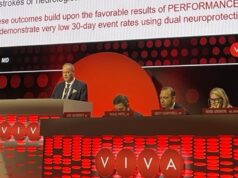
New white lesions are not a common occurrence in patients who have undergone transcarotid artery revascularisation (TCAR), a study in which patients were assessed post-procedurally using diffusion-weighted magnetic resonance imaging (DW-MRI), has found.
This was the finding delivered by Raghu Motaganahalli (Indiana University School of Medicine, Indianapolis, USA), who presented data from a multicentre, single-arm, open-label study evaluating the incidence and volume of new white lesions occurring within 30 days after TCAR. Motaganahalli told attendees of a plenary session at the 2022 Vascular Annual Meeting (VAM; 15–18 June, Boston, USA) that the outcomes of the analysis should serve as the benchmark for future comparisons evaluating carotid revascularisation strategies on cerebral new white lesions.
DWI has high sensitivity and specificity for the early detection of ischaemic lesions, Motaganahalli detailed in his presentation, noting that, on DW-MRI, early ischaemic lesions appear as new white lesions. Data from previous studies suggest that there is around a 17% chance of patients developing new white lesions following a TCAR procedure, Motaganahalli said, adding that the study presented at VAM 2022 is the first in the USA to evaluate the occurrence of new white lesions using DW-MRI.
For the study, a total of 55 patients were enrolled across five centres from the USA, as well as centres in Madrid, Spain, and Munich, Germany. Each patient underwent three MRI scans, one within the 72 hours preceding the TCAR procedure, another before their discharge from hospital, and a third at 30-day follow-up.
Relating to the study’s primary endpoint, detection of new white lesions from the DW-MRI scan, Motaganahalli detailed that new white lesions were seen in 14.5% of patients prior to the TCAR procedure, with a mean volume of 0.11cc. New white lesions were then seen in 21.8% of the study population in scans taking place between 12–60 hours post-procedure, with a mean volume of 0.03cc. Predominantly, these were distributed in the territory of the middle cerebral artery, Motaganahalli said.
“When you look at the 30-day follow-up, the majority of these lesions disappear,” Motaganahalli then detailed, adding that lesions persisted in only 5.8% of the patients assessed at this timepoint. The mean volume of the lesions at this point was 0.21cc, which were again predominantly located in the territory of the middle cerebral artery. No incidences of stroke or neurological death, the study’s secondary endpoints, were seen.
“Patients who underwent TCAR and DW-MRI post-procedurally had a low incidence of new white lesions,” the presenter told attendees of the Plenary 2 session. Of these, he added, the majority were in the ipsilateral hemisphere, and located in the middle cerebral artery territory and distribution.
“These lesions are very small, and those procedures [when] followed-up the majority of them are resolved,” Motaganahalli added. The results of the study should serve as a benchmark, and point to the detection of new white lesions as a surrogate marker for future carotid revascularisation clinical trials, he concluded.










